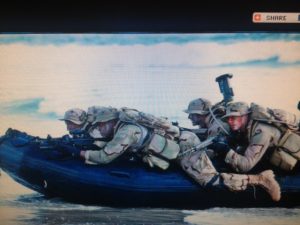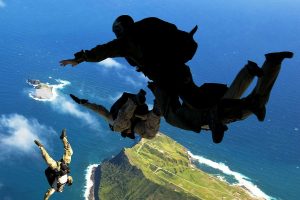You hear about them in movies and news reports. The U.S. Navy SEALs are legendary warriors renowned for their exceptional skill and unwavering dedication. This reputation often raises a significant question: just how many Navy SEALs are there, and how many SEAL teams exist?
The answer might surprise you. Getting an exact, to-the-minute count is tough because the numbers are constantly in motion. We can, however, get a very clear picture of this special operations force.
You came here seeking an answer about the number of Navy SEALs and the SEAL Teams that comprise this elite group. That is precisely what you will learn, along with how they are structured for global operations.

Table of Contents:
- The Real Numbers: Counting the Elite
- How Many SEAL Teams Are There? A Look at the Structure
- The Journey to Becoming One of the Few
- How Many Navy SEALs Are There and How Many SEAL Teams Compared to Other Forces?
- The Importance of the Support Network
- Why Do The Numbers Matter?
- Conclusion
The Real Numbers: Counting the Elite
Let’s get right to it. There are roughly 2,500 active-duty Navy SEALs. This small number highlights just how selective the force truly is, representing a tiny fraction of total Navy personnel.
When you consider the entire U.S. Navy has over 340,000 active personnel, the SEALs make up less than one percent of the entire branch. This figure includes both officers and enlisted men who have completed the arduous training pipeline. These operators form the core of the Navy’s special operations capabilities.
This number isn’t static, though. It changes with graduation rates from training, retirements, and the operational needs of the military and the global war on terror. However, the 2,500 figure provides a solid understanding of the community’s size.
How Many SEAL Teams Are There? A Look at the Structure
Knowing the total number of operators is one thing, but how are they organized? The SEALs are structured under the Naval Special Warfare Command (NSW). From there, they are primarily divided into Naval Special Warfare Groups (NSW Groups) on the East and West coasts of the United States.
This geographic split helps them deploy forces efficiently across the globe. Each of the warfare groups has its own set of teams with specific responsibilities. The basic structure comprises several core SEAL Teams, along with a few highly specialized units that handle unique mission sets.
The Naval Special Warfare Command also provides doctrinal guidance and oversees the training and equipping of all its forces. This command ensures that all units, from the individual SEAL platoon to the larger NSW Group, are ready for any mission. This top-level oversight is crucial for maintaining the high standards of the special operations forces.
East Coast Teams: Naval Special Warfare Group TWO
Based at Little Creek, Virginia, Naval Special Warfare Group TWO oversees the East Coast teams. These teams are typically oriented toward operations in Europe, Africa, and the Americas. The structure is built for rapid response in these theaters of operation.
The teams under Group TWO are SEAL Team TWO, SEAL Team FOUR, SEAL Team EIGHT, and SEAL Team TEN. While each team is capable of operating anywhere, this regional focus helps build expertise. They understand the languages, cultures, and environments of their assigned geographic areas, from the cold of Northern Europe to the deserts of Africa or the jungles of Central America.
These teams are supported by Special Boat Teams, like Special Boat Team 20, which operates advanced combatant craft. This close relationship between the SEALs and the Special Boat personnel ensures seamless insertion and extraction during combat operations. This integrated approach is a hallmark of Naval Special Warfare.
West Coast Teams: Naval Special Warfare Group ONE
On the other side of the country, in Coronado, California, is Naval Special Warfare Group ONE. This command oversees the West Coast teams. Their geographic responsibility is generally focused on the Indo-Pacific and Middle East regions.
The West Coast hosts SEAL Team ONE, SEAL Team THREE, SEAL Team FIVE, and SEAL Team SEVEN. Like their East Coast counterparts, they train for a wide range of missions, including operating in the Western Pacific jungle or the Middle East desert. Their regional alignment prepares them for the unique challenges of this vast and critical area.
You may notice the team numbers are not consecutive. SEAL Teams TWO, FOUR, EIGHT, and TEN are on the East Coast, while ONE, THREE, FIVE, and SEVEN are on the West Coast. This numbering system is part of a tradition that dates back to their founding and helps distinguish their home base.
The Specialized Teams: Beyond the Core Units
Beyond the conventional teams, there are units with particular and sensitive missions. You have probably heard of one of them. The most famous is the Naval Special Warfare Development Group, also known as DEVGRU.
DEVGRU is often publicly referred to as SEAL Team Six. This unit selects its operators from the existing community of elite SEALs after they have gained years of experience. They specialize in counter-terrorism, hostage rescue, and other high-stakes national security missions, often as part of a Joint Special Operations task force.
Their role places them at the pinnacle of the U.S. Special Operations Command structure. They frequently work alongside other top-tier units from the Army and Air Force. DEVGRU represents a level of experience and capability that is unmatched.

SEAL Delivery Vehicle Teams (SDV Teams)
Another highly specialized element is the SEAL Delivery Vehicle Team. The SDV Team operates miniature submarines designed to transport SEALs and their equipment covertly. Their job is to master underwater infiltration and exfiltration for missions launching from the sea.
These vehicle teams are essential for placing operators on a hostile shore without detection. The primary SEAL delivery vehicle is a free-flooding submersible, meaning the operators are exposed to the water while in transit. This requires incredible endurance and skill in underwater navigation.
The main SEAL Delivery Vehicle Team, SDVT-1, is based in Pearl Harbor, Hawaii, and falls under Naval Special Warfare Group ONE. Its location in the Pacific makes it a critical asset for operations in the Western Pacific. This specialized vehicle team provides a stealthy mobility option that is a core part of Naval Special Warfare.
| Command | Location | Primary Teams | Area of Responsibility |
|---|---|---|---|
| Naval Special Warfare Group ONE | Coronado, CA (West Coast) | SEAL Teams 1, 3, 5, 7 | Indo-Pacific, Middle East |
| Naval Special Warfare Group TWO | Little Creek, VA (East Coast) | SEAL Teams 2, 4, 8, 10 | Europe, Africa, Americas |
| Naval Special Warfare Development Group (DEVGRU) | Dam Neck, VA | Specialized Operators | Global |
| SEAL Delivery Vehicle Team ONE | Pearl Harbor, HI | Specialized Vehicle Team | Global Underwater Mobility |
Reserve Forces: Ready When Called
In addition to the active duty component, the Naval Special Warfare community includes reserve forces. These are SEAL Team SEVENTEEN (West Coast) and SEAL Team EIGHTEEN (East Coast). These teams are comprised of experienced former active-duty SEALs and other qualified personnel.
The reserve forces provide a crucial surge capacity for the Special Warfare Command. They can augment active teams, provide stateside support, or deploy to fill specific mission requirements. Their experience is a valuable asset to the overall force structure.
The Journey to Becoming One of the Few
So why are there so few SEALs? The answer lies in the intense training pipeline. The path to earning the coveted Trident insignia is one of the most difficult in any military worldwide.
It all starts with Basic Underwater Demolition/SEAL training, known as BUD/S. This six-month course is built to push candidates to their absolute physical and mental limits. The goal isn’t just to build them up but to find those who refuse to quit, no matter the circumstances.
The attrition rate for BUD/S is famously high, often hovering around 75% or even higher. For every 100 people who start, only 25 or fewer will finish. That alone shows why the total number of SEALs remains so small, as it is a filter that only the most resilient can pass through.
Phases of Torture and Triumph
BUD/S is broken into three distinct phases, each testing a different aspect of a candidate’s abilities. The first phase focuses on physical conditioning, water competency, and mental toughness. It culminates in “Hell Week,” a five-and-a-half-day period of continuous training where candidates get about four hours of sleep total.
Phase two is all about combat diving. Candidates become expert combat swimmers and learn to use underwater breathing apparatuses for tactical missions. This phase builds on the water skills developed in phase one and turns them into operational tools.
The final phase is land warfare training. Here, the remaining candidates learn about weapons, demolitions, and small-unit tactics. After completing all phases of BUD/S, the journey is still not over for the remaining Navy personnel.
Following BUD/S, graduates attend Parachute Jump School and then move on to SEAL Qualification Training (SQT). SQT is another lengthy course where participants learn advanced skills in areas such as communications, medical aid, and close-quarters combat. Only after SQT do they earn their Trident and become a Navy SEAL assigned to their first SEAL platoon.
How Many Navy SEALs Are There and How Many SEAL Teams Compared to Other Forces?
To appreciate how exclusive this community is, let’s put their numbers into context. We mentioned the roughly 2,500 active-duty SEALs. Compare that to the nearly 700,000 soldiers in the entire U.S. Army.
Even within the special operations world, the numbers are tight. It is widely accepted that the U.S. Army Special Forces, also known as the Green Berets, comprises several thousand operators. The Army’s 75th Ranger Regiment is also larger than the active-duty SEAL force.
The Air Force Special Operations Command also fields a variety of elite units, each with its own specialized roles. The relationship between the different branches, such as the Army and Navy special operations communities, is one of cooperation under the U.S. Special Operations Command (SOCOM). Each force brings a specific skill set to joint special operations.
This comparison isn’t about which force is “better.” Each has different missions and capabilities. But it does show that the Navy SEALs are intentionally kept as a small, specialized, and elite force, a key part of their identity.
The Importance of the Support Network
The 2,500 SEALs are just the tip of the spear. For every operator in the field, there is a large network of support personnel making the mission happen. Naval Special Warfare Command employs about 10,000 people in total.
This includes thousands of dedicated sailors and civilians who work in intelligence, communications, logistics, and medical support. There are also the Special Warfare Combatant-Craft Crewmen (SWCC), who operate the high-speed boats that insert and extract SEALs. The special boat teams are an indispensable part of the naval special warfare group structure.
So when you think of the strength of the SEALs, it is important to remember the entire NSW community. The operators are the most visible part, but they are components of a much larger team. Everyone plays a part in the success of the mission.
Why Do The Numbers Matter?
You might ask why the force is kept so small. Why not just train more people? The small size is a strategic choice rooted in the force special operations concept.
This intense investment creates a force where every member is a master of their craft. It also fosters an incredible level of trust and unit cohesion. In a small team where everyone has gone through the same trials, you know you can count on the person next to you.
This model allows for agility and flexibility that a larger force might struggle with. Small teams can plan, train, and deploy rapidly to respond to crises anywhere on Earth. Their size is a direct reflection of their intended purpose as a precision tool of national power.
Conclusion
Its small scale and high standards define the community of the Navy SEALs. With around 2,500 operators spread across a handful of core teams and specialized units, they are one of the most exclusive fighting forces ever assembled. The demanding path through BUD/S ensures that only those with unparalleled drive and resilience earn the Trident.
Their structure, split between the East and West Coasts, with commands focused on seal missions, is built for global reach and effectiveness. Units like DEVGRU and the SEAL Delivery Vehicle Teams provide specialized capabilities for the most sensitive combat operations. The small numbers allow for incredible investment in each operator, creating a highly agile and lethal force.
The complete answer to how many Navy SEALs there are and how many SEAL teams exist isn’t just about the figures. It’s about understanding why this elite community is intentionally small, incredibly skilled, and strategically organized. Their size is a direct contributor to their legendary effectiveness on the battlefield.
